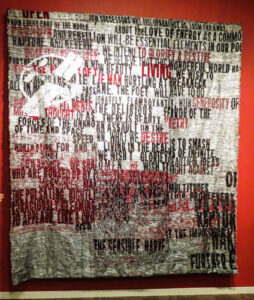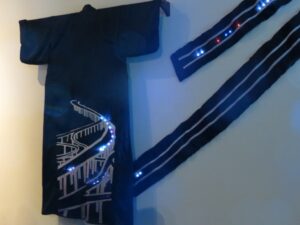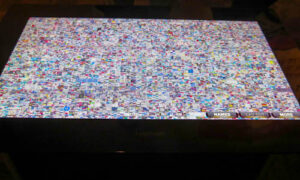The San Jose Museum of Quilts and Textiles’ International Techstyle Art Biennial explores art and technology. For example, the Microsoft Surface table, SUR40, is used to display the AIDS Quilt in a digital, searchable format.
There is no homier activity than sewing, quilting, and working with textiles. Textiles generally invite one to reach out and feel them, and in this aspect, textiles seem far removed from the digital. Digital content is light in a box: beautiful, seductive, but not tactile. Yet, there are always intersections in art. The San Jose Museum of Quilts and Textiles has sought out art that crosses the line between traditional textile crafts and technology for its second International Techstyle Art Biennial (ITAB). The museum invited artists to submit work, which would be selected on the basis of the ways they used or commented on technology in their work.
The results are a broad range of pieces. Many of them use the computer in the conceptualization process. Adobe’s Photoshop and Illustrator have played a role in the majority of the pieces, but the use of a computer alone was not enough to qualify. In fact, there were also a respectable number of artists in the show who say they don’t use computers much, but all the works played with different ideas about what textile art has to do with modern technology.

One, piece by Yumika Tanaka combined the ideas of clothing, networks, and freeways. She used micro-controlled LEDs to create a kimono decorated with pulsing lights coursing along highways. The lights continue on to the obi sash. Hung on the wall, the kimono and sash made one think about networks and connections as well as highways. It combines the personal and the public It is part of Tanaka’s “We Are What We Wear Series.” Tanaka started thinking about kimonos, their tradition, and their role in society and specifically kimonos in her life after she inherited her mother’s formal silk kimono. Her work she said, transforms the typical form of the kimono and puts it in the context of a modern environment with different kinds of highways and different kinds of traffic.

In contrast Wendeanne Ke’aka Stitt’s piece Niho Mah? II: To You, Año Nuevo Great White is a quilt made using dyes from traditional Hawaiian, hand dyed Kapa (bark ) cloth, is a quiet little joke about the relationship of art and technology. Hung on the wall, the quilt looks like a 3D representation of a bowl and Stitt used Adobe Illustrator’s 3D filter to map her quilt pattern, to be pieced, appliqued, and quilted. It’s a lovely piece that holds its own among the flashier, blinkier, pieces in the exhibit.
A common theme in the exhibit is the natural link between weaving and computers. The first proto-programs were created to define the steps for a jacquard loom to create intricate patterns and they were preserved on punch cards—a critical first step in the creation of the computer. It was the jacquard loom punch card that inspired James Babbage and Ada Lovelace as they worked on ideas for Babbage’s Difference Engine. Lovelace is credited with creating the first algorithms.

There were many woven pieces but one of the talkier wall hangings was Open’s Manifesto (Manifesto – 1) by Leslie Terzian Markoff. Created in honor of the San Francisco Museum of Modern Art’s OPENfuture celebration of the 100 year anniversary of the Futurist Manifesto published in Le Gigaro by F.T. Marinetti in 1909. Marinetti also published a Futurist cookbook and it is this aspect of the Futurist movement that formed the centerpiece for the San Francisco sfMoMA event, called OPENfuture: Spinning Marinetti’s Wheels. OPENrestaurant founder Sam White wrote his own take on the Futurist Manifesto for the event. The Open’s Manifesto weaving is an example of the jacquard process of weaving. It was created with rich red yarns and tin foil. It joins the old and new in its choice of materials and its use of the original Futurists’ style and art as well as quotes from the White’s Manifesto. “Seed the sensible … Harvest the impossible.”
Going the other way: from quilt to computer
As part of the San Jose exhibition, Microsoft brought its Surface display featuring a new application developed to display the NAMES Project AIDS Memorial Quilt. It is not part of the Biennial itself, but it fits in well with the spirit of the exhibit and co-exists comfortably with these pieces.
The AIDS Memorial Quilt began life in 1987 as the numbers of people dying from the AIDS virus demanded some form of recognition beyond a notice in the newspaper. People began making quilt squares to remember those lost in the epidemic and the effort to maintain those quilt squares and stitch them together into a larger quilt was managed by the non-profit NAMES Project. Now, there are almost 50,000 quilt panels in the AIDS Memorial Quilt. Weighing 52 tons and taking up 23 acres in space, the Quilt is too big to be displayed all at once and many panels are getting increasingly fragile. Not everyone sewed their panels using traditional techniques. People put them together as best they could using the materials they had — glue, string, yard, fabric, plastic — using what talents they had for fabrication. And, of course, it’s still growing, squares are still being added because people are still dying of this disease that has no cure, yet. The Quilt was displayed this summer on the National Mall in Washington, DC with the help of volunteers who carefully unpacked sections of the Quilt and continuously laid it out. In order to display it all they rotated sections.

A searchable version of the Quilt has come to Microsoft’s Surface platform as a result of work done by Anne Balsamo and Dale MacDonald (both from USC’s Annenberg Innovation Lab) and Scott Minneman (from Onomy Labs, Inc.) and by Donald Brinkman of Microsoft Research Connections. Brinkman oversees MSR’s digital humanities work and through a series of chance meetings and lucky accidents including Brinkman’s volunteer work on the display in Washington, DC, he met Anne Balsamo who is also on the board of the NAMES Project. It was Balsamo’s ambition to make the digital quilt searchable, zoomable, and reconfigurable. Brinkman, says in his blog that as he talked to Balsamo he realized that Microft had the resources to make it happen. As he says, Windows Azure can create cloud data stores and run the stitching and unstitching scripts, and Pivot Viewer could dynamically reconfigure the quilt. Silverlight could come into play with Deep Zoom to enable exploring the quilt and he says Microsoft has something called Large Art Display on Surface to provide a high-fidelity experience
Sure, Microsoft has the technology but a project like the AIDS Memorial Quilt needs more than technology. It more money and work than the NAMES Project had. Brinkman turned to Microsoft’s Garage, a volunteer organization of Microsoft employees. Brinkman said he found the volunteers he needed within hours and they managed to put together a digital version of the Quilt within a week.
There is more work to be done and it’s ongoing. Microsoft has donated four Samsung SUR40 Surface devices using Microsoft’s PixelSense technology to the University of Iowa and Brown University to continue work on the exhibits. They created the AIDS Quilt Touch application to enable the creation of an app that allows people to search the digital quilt by touch and to zoom in and out as well as to search. And work is continuing to add content to tell the story of AIDS and the evolution of the AIDS Memorial Quilt. Also the metadata attached to the Quilt is still sketchy and work is being done to try and recover information.
The one thing that’s screamingly obvious about the digital version of the AIDS Quilt is that it can’t be touched, the tactile qualities of the quilt are absent in this so-called “touch” display. Just being able to look at the quilt without understanding what the materials used feel like, is a compromise. The Surface machine sits in a room surrounded by a three large panels of the AIDS Quilt and together the application and the real panels let us see something that’s difficult for anyone to actually experience any more. In addition, if the group can improve the available metadata attached to the quilt and help preserve and tell the stories behind the quilt, the application goes further to preserve and terrible and brave part of human history.
The AIDS Quilt Interactive is being displayed on a 42-inch Surface display at San Jose Museum of Quilts and Textiles in concert with the museum’s International TechStyle Art Biennial.
What do we think?
So, it might seem all this is only tangentially connected to computer graphics, our focus at GraphicsSpeak, and well, maybe it is. But, let’s try this out. We now have at least two generations of adults who have lived and worked with computers. It’s a good time to crack open that box of light and think about the ways in which it goes out into the world with us—not just in our pockets as mobile phones, but also as technology we meet in the streets and interact with on signs, and in information kiosks, and increasingly as AR applications that superimpose the real and the digital.
It is also another expression of coming age of computer technology as heralded by the Makers, which seeks to take advantage of technology to make a more beautiful, comfortable, fun and efficient world. If we’re going to spend so much time with our heads in computers the least we can do is use them to make life better when we pull our heads out.
The exhibition will be up through October 14, 2012. If you get to San Jose in that time, have a look.
Related Posts
Redefining Production in the age of digital reality
Kinect hack wizards vie for tech star fame





